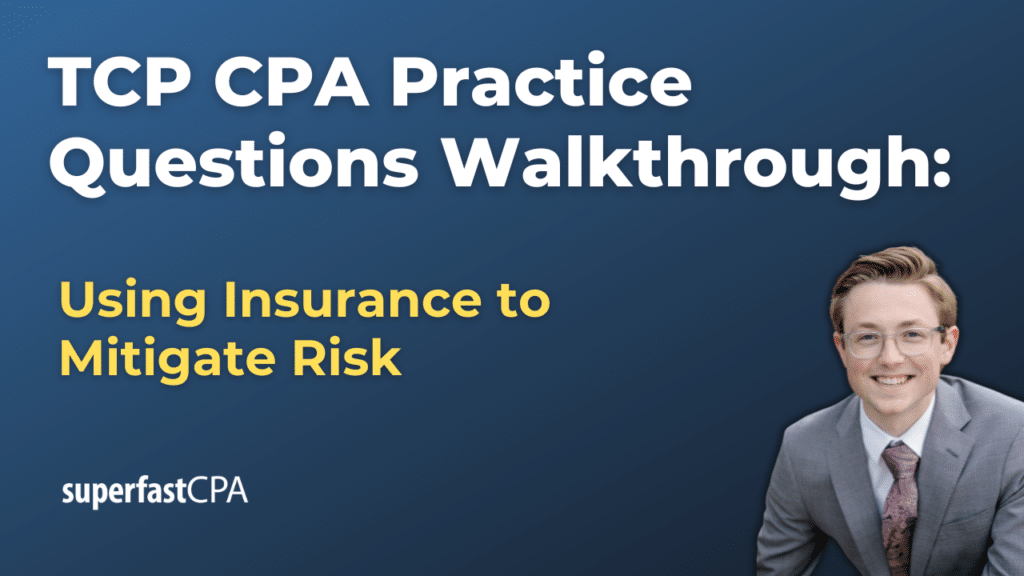In this video, we walk through 5 TCP practice questions teaching about using insurance to mitigate risk. These questions are from TCP content area 1 on the AICPA CPA exam blueprints: Tax Compliance and Planning for Individuals and Personal Financial Planning.
The best way to use this video is to pause each time we get to a new question in the video, and then make your own attempt at the question before watching us go through it.
Also be sure to watch one of our free webinars on the 6 “key ingredients” to an extremely effective & efficient CPA study process here…
Using Insurance to Mitigate Risk
Using insurance to mitigate risk is a fundamental aspect of personal and financial planning. Insurance policies serve as a safeguard against the financial consequences of unforeseen events, ranging from illness and disability to legal liabilities and long-term care needs. Each type of insurance addresses specific risks and provides targeted protections. Here’s an overview of some different types of insurance:
Term Life Insurance
Term life insurance provides financial security for a specified period, such as 10, 20, or 30 years, offering a death benefit to the insured’s beneficiaries if the insured passes away during the term. For example, a parent might purchase a 20-year term life policy to ensure that their child’s education costs are covered in case of their untimely death. This insurance is more affordable than permanent life insurance and does not include a savings component, focusing purely on providing a safety net for beneficiaries.
Permanent Life Insurance
Unlike term life, permanent life insurance offers lifelong coverage and includes a cash value component that grows over time. This category includes whole life and universal life insurance. Whole life insurance has fixed premiums and a guaranteed death benefit, making it a stable, albeit more costly, option for lifelong coverage. Universal life, on the other hand, offers flexible premiums and a death benefit that can be adjusted based on the policyholder’s changing financial circumstances. For instance, an individual might use a universal life policy to assist with retirement planning, leveraging the policy’s cash value that accumulates tax-deferred.
Disability Insurance
Disability insurance protects against income loss due to short-term or permanent disabilities that prevent an individual from working. For example, a surgeon who develops chronic hand tremors can receive a portion of their regular income through disability insurance, maintaining their standard of living despite being unable to perform surgeries.
Long-Term Care Insurance
This insurance covers services that regular health insurance, Medicare, or Medicaid might not cover, such as nursing home care, assisted living, or in-home care. Long-term care insurance is crucial for individuals who face chronic illnesses, disabilities, or the effects of aging that require daily assistance. An example might be an elderly person who develops Alzheimer’s disease and requires extended nursing home care, which could be financially overwhelming without the right insurance coverage.
Umbrella Insurance
Umbrella insurance provides additional liability coverage beyond what is included in homeowners’ and auto insurance policies. This type of insurance is essential for protecting personal assets against lawsuits for major accidents that may occur on your property or because of your actions. For example, if a homeowner’s dog severely injures someone and the medical and legal costs exceed the homeowner’s standard liability coverage, an umbrella policy can cover the excess costs, protecting the homeowner from significant financial loss.
Summary
Each type of insurance plays a critical role in risk management by addressing specific vulnerabilities. By choosing appropriate insurance policies, individuals can protect themselves, their families, and their assets from the significant financial strain that can accompany unexpected events. The key to effective use of insurance for risk mitigation lies in understanding the unique features and benefits of each type of policy, ensuring that coverage aligns with personal needs and life situations.













